

 |
 |


|
It's a Mad, Mad, Mad, Mad World of
Springfield!
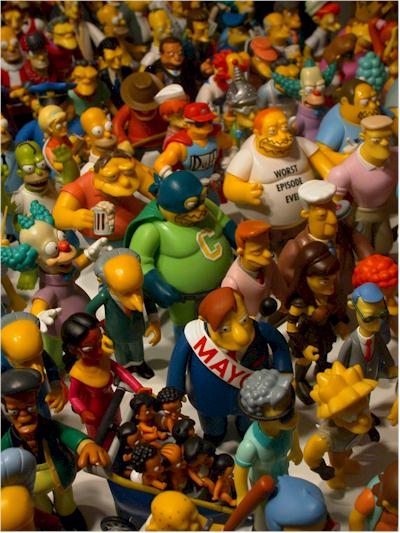 |

|
I feel it necessary to warn you. This feature is VERY long. VERY, VERY long. When I sat down to start writing it,
referring back to my many emails, archives at the Simpsons Collectors Sector, and personal notes, I didn't realize just how much history was here, and how much I wanted to discuss. Now that it's done, I realize there's even more I could have said - and perhaps, if I can get a project off the ground to write an actual book on the line, complete with lots and lots of photos, all that history will see light. Hmmm...if you'd be interested in just such a book, let me know...it may spur me on to get moving.
Back to the subject - this is a long feature. If you plan on being here at the end, settle into a comfy chair.
I'm going to try to discuss the line as chronologically as possible, but I
make no promises. This thing may just take on a stream of
consciousness
flow if I take Punch Drunk Bunny's advice and have a couple margaritas while
I'm writing it. I've also add almost three dozen photos, but they aren't
intended to match up with the text, so don't try to read too much into the
placement of each one. Instead, they are some groupings of figures,
some logical, some not so logical, and I think I have just about every
figure in at least one photo, including the dreaded Bongos. There are
actually two figures that I know of that are missing due to circumstances at
the time I did the shoot, but only the sharpest eyed readers are going to
notice. Now let's take a little trip back in time...
The year was 1999, and I had been collecting action figures for over a decade. In that time, I'd seen a lot, but nothing quite like what was about to hit the market.
When you collect long enough, you go through phases. By 1999, I knew my habits well, and could categorize my level of insanity for a new line in one of four ways, similar to a terror alert - "green" means zero interest, I'm not buying a thing, and won't even riffle the figures on the pegs. "Yellow" means I'll be sucked in for a couple figures, the ones that are really cool, but some level of self control will still exist. "Orange" means I'll be flirting with obsessive/compulsive, although I'll still be able to pretend I'm a normal, productive member of human society. I'll be some sort of
completist, but I'll ignore certain ridiculous items, like packaging variations or minor paint variations. I'll probably also open most if not all of the figures in the line.
Then there's "red". This color generally implies danger, and in my mind, B-9 is swinging his little robot arms like mad. A line that elicits red level collecting is one that my wife will add to her arsenal of proof that she should be
given power of attorney. This is a line in which all pretense of sanity will be
forsaken, and I WILL be a completist, taking that to it's ultimate limit. I will have a full set of everything, goofy as it might be, carded, AND I will have at least a majority of the line open and on display, often at great cost to the perception of my mental health. In 1999, when the World of Springfield was first announced by Playmates, my collector alert shot to red and never left.
|
|
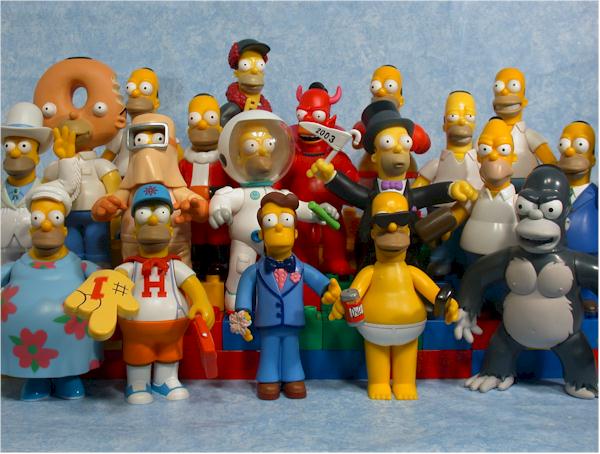
|
|
Although the line was announced that summer, we didn't see pictures til November.
Raving Toy Maniac was the first place I saw photos of wave 1 and the
playsets, only a couple months before actual product hit the shelves. They missed Christmas that year, hitting in real numbers in January of 2000. Although I'd been writing on-line reviews for at least five years on various message boards and Usenet, the official Michael's Review of the Week website was still a month away, and so wave 1 - consisting of Homer, Bart,
Grampa, Lisa, Krusty and Mr. Burns - wasn't reviewed. (I have made up for that this week with a
retrospective review of the line - it's that completist thing again.)
FOX was convinced that kids loved the Simpsons, and Playmates started out the line intended for kids. Playmates was also (and still is) focused on providing toys that had some sort of interactive electronic feature, and thus was born the Intellitronic voice feature. Each figure has a device in their feet that provides electrical resistance, and when plugged on to the peg in a
play set, allows the set to play specific lines for the character. Matt
Groening was a huge fan of this idea, and thought it was great they would
talk.
With wave 1, two playsets were released, the Nuclear Power Plant and the Simpson's Family Living
Room. The line was always international from day one, but the playsets spoke English - except for the initial wave. There are Living Room sets that speak in Spanish, and are one of the toughest items in the entire series to find.
There's never been a Power Plant reported that does this, and Playmates
doesn't believe any were ever made. *NOTE* I've heard from several
Spanish collectors that do in fact have power plants that speak in Spanish!
***
Part of the kid-focus was to heavy pack Homer and Bart in the first series case assortment, and shortpack Lisa, Burns, Krusty and
Grampa. Lisa and Mr. Burns were particularly tough to find, and while Homer and Bart warmed the pegs in many areas, the shortpacks flew off the shelves.
|
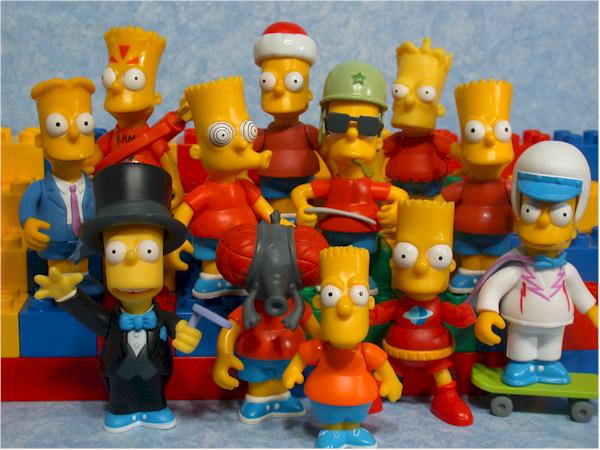
|
|
Toys R Us was the first retailer to really back the line, and they stuck with them through out. While the road was bumpy at times, TRU seemed to always have a stake in the outcome of the series, and even worked to develop a strong relationship with the collectors. More about that later...
One year after the initial announcement of the line, the next big announcement came in the form of the Treehouse of Horror exclusives with
TRU. These
play set exclusives would prove to be some of the most popular of the entire series, and further cemented the tie between
that retailer and WOS.
Later that summer, wave 2 figures and playsets
hit. Notice that months had passed since wave 1 - Playmates took it very slow in the beginning. Wave 2 consisted of our first variants of Bart and Homer, Pin Pal Homer and Sunday Best Bart, along with Chief
Wiggum, Ned Flanders, Barney and Smithers. Smithers wasn't available in the initial cases, and was shortpacked thereafter. The line was heating up with collectors at this very same time, causing Smithers to be the first big scalper target in the line. And just to put the rumor to rest, Smithers was never short packed due to his sexual orientation, but due to the initial assumption by Playmates that this was a line for kids, and they'd have little interest in
Smithers.
Wave 2 would be the last wave to have shortpacks, and be aimed at a kid audience. By Wave 3, Playmates had figured it out, although FOX
would never fully understand.
|
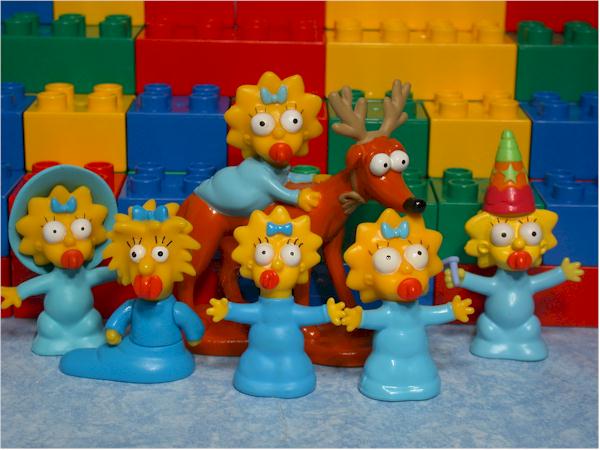
|
|
About this same time, Toyfare had their first exclusive WOS figure, the Glow in the Dark
Homer. Nothing more than a repaint (actually, different plastic was
used) of the Homer that came with the Nuclear Power Plant, the run of 10,000 figures actually took quite awhile to sell through. In the coming months, as collector interest expanded exponentially, this figure would become the holy grail for many.
But the collector interest wasn't soaring yet. Sure, it looked like Playmates had a decent hit on their hands, but the tsunami of demand hadn't hit yet. The
first THOH set hit Toys R Us in late September, and contained one of the best general assortments of THOH characters to ever see plastic - Fly Bart, Devil Flanders, Dracula Burns and
King (Kong) Homer. But the price tag of $30 was more than most collectors were willing to spend at this point, and the set ended up on clearance at 50% off! Over the long haul, this set became one of the more sought after as well.
Things did continue to heat up though. The coupon for the GITD Homer was in issue #37 of
Toyfare, and the first large Simpsons collecting website
kicked off, the Collecting Simpsons! message board. By the end of the year, Toyfare has named it the Best Toy Line of 2000, although only wave 1 and 2, along with the corresponding
playsets, had hit stores. By the time January of 2001 rolls around and wave 3
figures and playsets hit - including Sunday Best Homer, Moe, Kamp Krusty Bart, Nelson, Milhouse and Otto - the mania over the line has sunk in. Wave 3 was even packed, and there would be no more shortpacks through the entire history of the line.
|
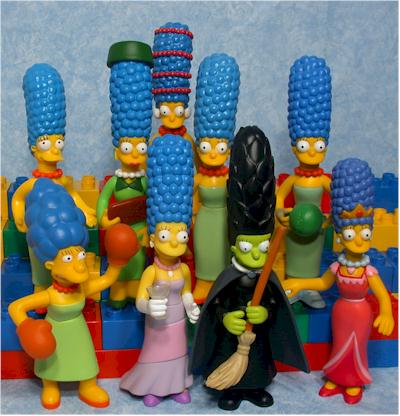
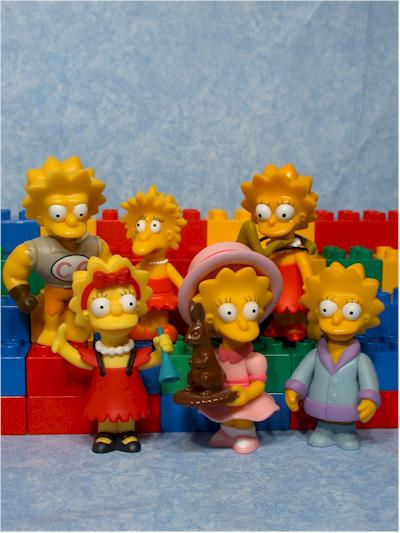
|
|
The accolades from the various magazines continued, with Lee's picking WOS as the Best Action Figure Line in the Comic Book/Animation category, and the reader poll in Tomart's giving Most Popular Action Figure Line for 2000 to
WOS. This was of particular interest, as Star Wars had
won every year for the previous four years.
From here on out, at least for the next year or so, just about every issue of
Toyfare, Lee's and Tomart's has some mention of WOS. In just a few months, from December of 2000 until March or April of 2001, the collecting fanbase for WOS skyrocketed, and by the time the second Toyfare exclusive,
Pin Pal Mr. Burns, goes up for sale in June, things are at a fever pitch. The first Toyfare exclusive, GITD Homer,
was now hitting prices of better than $100 in ebay auctions. The outcome with PP Burns was almost inevitable.
Remember, GITD Homer sold okay for Toyfare, but nothing stupendous. Therefore, it's not surprising that the Toyfare's run size on PP Burns wasn't a whole lot larger than the 10k they did for Homer. However, the demand had changed considerably. Pin Pal Burns was gone almost immediately - it seems to me and my foggy memory like he sold out within a day at their on-line store, and many, many people got their checks returned from the magazine mail away. By mid-July, Toyfare was already setting secondary market prices on the PP Burns figure, although he hadn't yet shipped to those that had ordered him. By the end of July, something smelled fishy to many collectors, including me, about how Toyfare was handling the disbursement of the figures. Rather than go into the whole story here, you can check out the articles
(Pin Pal Burns article, Pin
Pal Moe article) I wrote on the situation at the time.
|
|
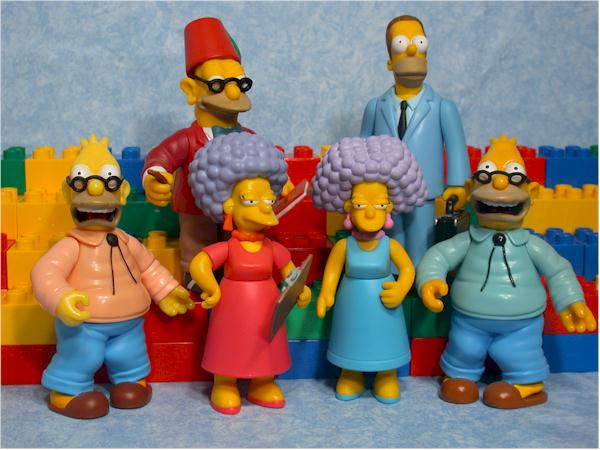
|
|
One thing's for sure - Toyfare knew a hot property when they saw it. They quickly jumped on more single figure exclusives, announcing
Pin Pal Moe, Boxing
Homer, and 'convention' Comic Book Guy. These figures would all see release and shipment through Toyfare by the end of 2001, but the uproar from
collectors over how they were ordered, distributed, and handled was huge. And because of a new site that popped up that summer, fans had a way to express their anger.
The new site was the Simpsons Collector
Sector, started in June of 2001, after the sudden closing of the Collecting
Simpsons! message board. Started by Mark
Lindsey, with help from Jonathan Cook, James Murray, Jeremy Wilcox, and a handful of others, the site quickly became the number one source for WOS information. I joined up with the group in July, and brought with me my connections into the toy industry.
I had known Jeff Trojan, VP of Boys Toys at Playmates, from another older group,
Playtrek. This group had been formed for the Playmates Star Trek line, and Jeff had always been very helpful in providing info and listening to feedback with that group. I wanted to take that to another level with
WOS, and brought Jeff and the SCS together to collaborate. What came out was one of the closest, most valuable relationships I've ever witnessed between fans and a company.
|
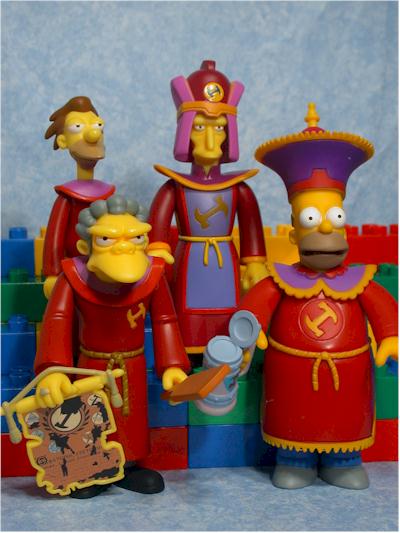
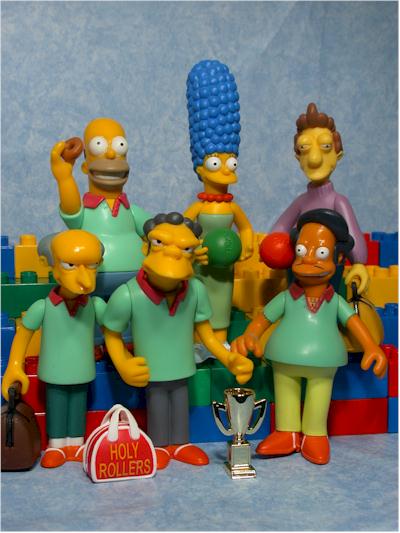
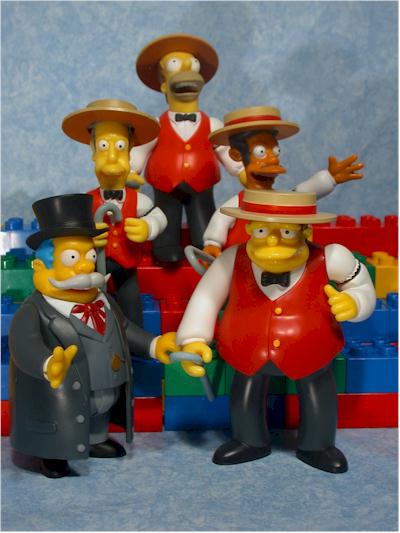
|
|
Of course, it took time to develop the full relationship, but even in those first couple months, the connection to Playmates allowed the SCS to bring the outcry of the fans over the Toyfare exclusives directly to Playmates. The result was the end to single figure exclusives for
Toyfare, under the official guise that Playmates would simply end the practice altogether for 2002.
That summer, the SCS started their top ten questions with Jeff Trojan. This gave the fans a chance to select ten questions they wanted answered directly by the guy in charge, and it was a tremendous hit. The ten questions format continued for many months, and was a great method for communicating between Playmates and the collectors.
Somewhere in all these months, wave 4 and wave
5, along with the playsets (Android's
Dungeon and Bowl-A-Rama) hit the
shelves.
The sharp eyed reader will notice that's two
waves of figures, but only one wave of playsets...what was up? The playsets
had officially never been tied to the actual waves, although they
were always released at about the same time. They also were numbered
for each release, just like the waves. However, with the blip in the
scheduled release of what WOULD have been assortment 4, the Android's
Dungeon and Bowl-A-Rama were called 'assortment A' officially by Playmates,
and the went with the alphabet after that. There were no playsets released at the same time as wave 5.
It was really the fall of 2001 where I think WOS collecting peaked. Between the first week of October and the first week of January, a period of only three months, we saw the
THOH2 set, Radioactive Man and Fallout Boy set, first
Family X-mas set, Waves 6 and
7, Krusty Burger, Kitchen,
the Arcade, and Church playsets, all on the pegs and shelves, and the shipment of Boxing Homer and the Convention Comic Book Guy shipped from
Toyfare. There was plenty of yellow plastic that Christmas!
|
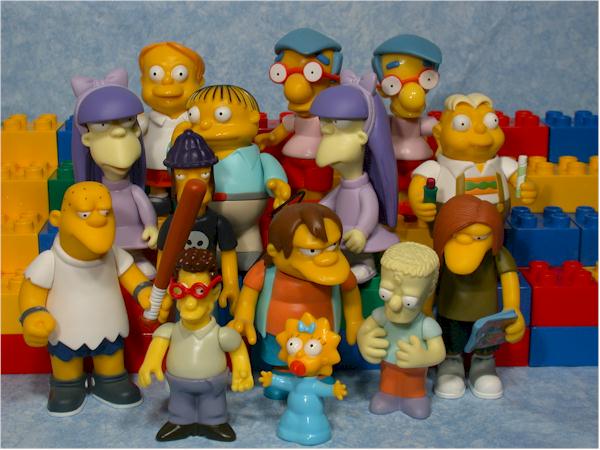
|
|
Was it all too much too fast? That would be an area of debate for some
time, but what was is certain is that the first serious troubles for the line were right around the corner. But before we get there, let's back up a minute.
The Simpsons Collector Sector were heavily involved in the fate of two playsets
through this period. First, there was Main Street. The huge Main Street playset originally debuted at the 2001 Toy Fair, but was cancelled due to a lack of retailer interest quickly after. It was too big, it cost too much, and it took up too much shelf space. Playmates retooled the idea, making it smaller, changing the figures included, altering the price point. They also came to the SCS for help.
Working with the SCS, they were able to produce poll results strong enough to convince Toys R Us to move forward with Main Street in 2002, in it's original form and at the original price point. And collector's rejoiced, although the set did eventually have to hit clearance to completely sell through.
Another playset that had quite a colorful history was Moe's
Tavern. Very early on, in the spring of 2000, artwork for the possible set was released. Hey, let's face it - it only made sense as one of the most popular and common sets on the show. But Playmates ran into a snag, as someone in the approval chain, most likely FOX, didn't feel it was the right message to send. Remember, FOX still believed this line was a kid's line, and didn't feel selling them a toy bar was the best idea.
|
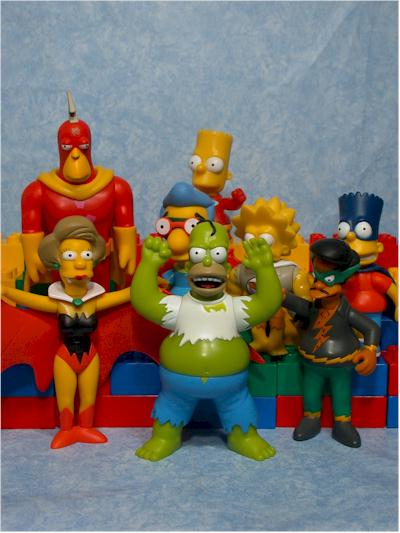
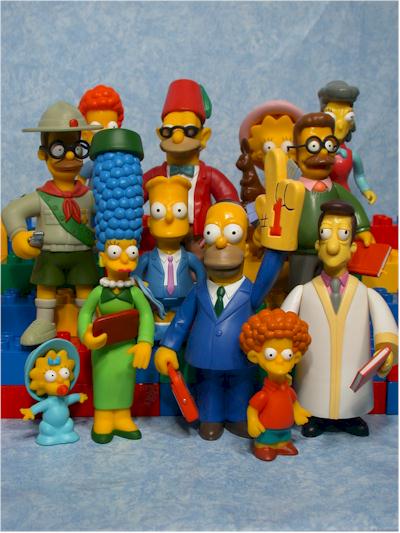
|
|
It was a long, uphill struggle, but SCS worked closely with Playmates and finally they were able to convince FOX to approve the set, under the condition that it would be released only in the specialty retailer market, where the theory was that fewer small children would have access (and there was less chance for complaint). Moe's Tavern finally saw the light of day in 2003.
When it was released, rather than containing a version of Moe, it contained
Duffman. Duffman had been a much requested figure by collectors, but
it still seemed an odd choice to include with the bar, rather than as a
single packed figure. This was also due to the same concerns from FOX,
since Duffman was a spokesman for a beer company. By including him
with Moe's, sold in a way that reduced FOX's concern, Playmates was able to
get him produced, something that might not ever had been possible otherwise.
All through the history of the line, the SCS provided invaluable info to Playmates. They answered questions, personally met with top management to discuss the line, tested out ideas early on, and provided important marketing information. Playmates provided SCS with early prototype photos, breaking news, and allowed collectors the opportunity to have an unprecedented level of input to the line. Other companies, especially smaller ones, have learned from this model, and the work SCS and Playmates did helped break new ground in communications between companies and collectors.
|
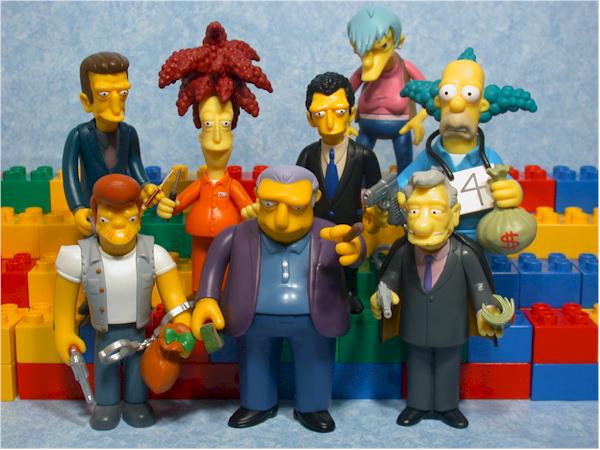
|
|
There was a third playset during the fall of 2001 that never made it past the concept drawings. Toys R Us wanted something back from the line, since they'd been such a major supported, and proposed that they develop a
New Year's Eve themed set depicting OFF celebrating in front of the Toys R Us store in Times Square. Playmates and TRU were unsuccessful in getting the approval for this though - remember, if it wasn't seen on the show, it wasn't supposed to be made. At the same time there were rumors that TRU tried to get a Pimply Faced Teen figure produced wearing a TRU smock, to be given to TRU employees, but that one was false.
Let's return to our little trip in the way back machine. It's early to mid 2002, and the line is still riding high, with waves coming out with as little as three months in between, plus the additional product cranking up.
Wave 8 and wave
9 hit the streets, along with the playsets the Cafeteria,
DMV, Retirement Castle and Police Station.
Playmates wanted to add in more 'celebrity' characters - those voiced by celebrities, but not actual celebrities themselves. Because the rights to their voices were more expensive, and often more difficult and time consuming to negotiate, Playmates decided to break those figures off into their own SKU, under the name of the 'celebrity series'. In February of 2002, the
first series hits stores, including Phil Hartman as Troy McClure, Danny Devito as Herb Powell, and Joe Mantegna as Fat Tony.
The Celebrity Series was fairly strong out of the gate. Both Fat Tony and Troy McClure seemed like good choices, but Herb Powell had weak sales. Still, they sold fairly well, but it wasn't going to last.
|
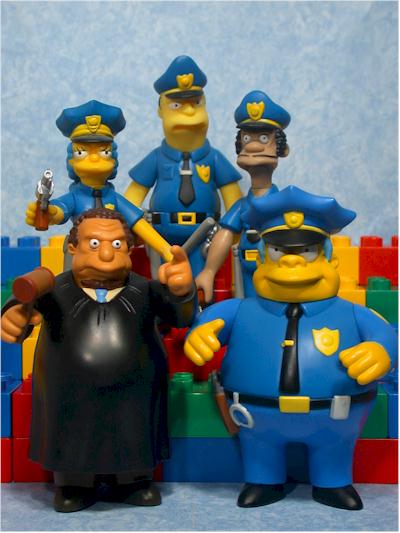
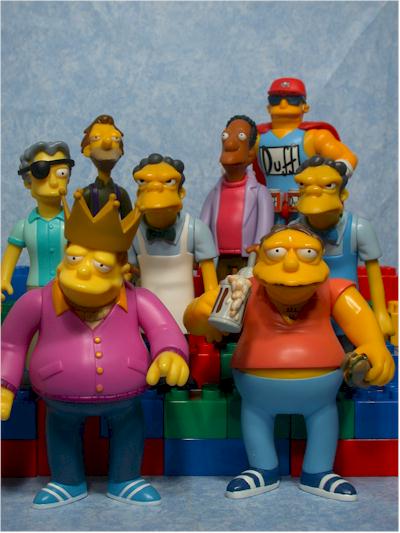
|
|
Series 2 hit in June, and was cut from three figures to two - Phil Hartman as the popular sleazy lawyer Lionel
Hutz, and Albert Brooks as
Brad Goodman. Ah, yes, Brad Goodman.
While Hutz sold well fairly, Brad Goodman was a complete stinker. Brad Goodman is considered by many the worst figure in the entire series, not because he looks off model or was of poor quality, but because no one was particularly interested in the character. He was certainly the biggest peg warmer of all of
WOS, and if you look carefully you'll still find him at some stores, almost three years later.
The third figure planned for that set would have been a hit - Rabbi Krustofsky, voiced by Jackie Mason. Unlike
the Blue Haired Lawyer, Hutz, and Powell, he wasn't just another guy in a suit. He made it all the way to the initial sculpting stage, but the contract negotiations with Jackie Mason over the voice broke down. Or at least with his
manager and wife. There were rumors that Mason felt the action figures accessories were disrespectful to his religion, but insiders felt it was simply a monetary issue. Whatever the case, the Rabbi would never see the light of day, and his loss created a very weak second series. The announced third series didn't have a snowball's chance in hell.
Sure enough, they were cancelled later that summer. The assortment was to consist of Jim Varney as
Cooder, Jon Lovitz as Llewellyn Sinclair, and Albert Brooks as Hank Scorpio, a very popular choice with fans. Playmates knew that these three characters were stronger than some of the previous celeb figures, and they'd already signed and paid for the voice rights, but retailers weren't biting, so they had to get creative and find a way to get them to market.
|
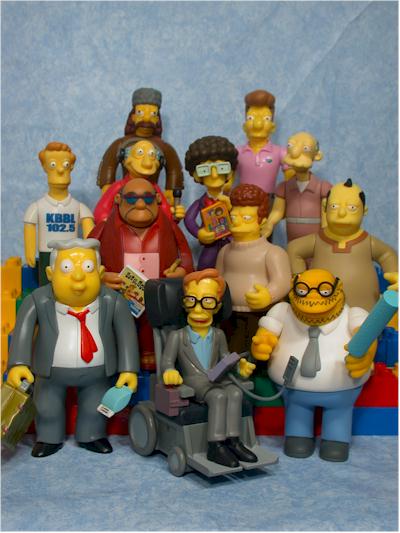
|
|
They knew that Scorpio was a solid choice, so they placed him in
wave 10, but still wanted to include all six regular figures already planned for wave 10. To do so, they created a rather unique case pack set up, where there were several different assortments, designed to even out the distribution of all seven figures over the entire run.
There were two case assortments - Case A: 2 SC Homer, 2 SB Marge/Maggie, 2 SL Flanders, 2 Dr. Monroe, 2 Wendell, 2 Resort
Smithers,
and Case B: 2 SC Homer, 2 SB Marge/Maggie, 2 SL Flanders, 2 Dr. Monroe, 2 Wendell, 2 Scorpio.
The cases were to ship in a 50/50 ratio.
There was mass confusion with the collectors and on-line retailers, since so many people ordered complete sets, but by the time the dust settled and the actual product hit shelves, everyone was able to get full sets pretty easily, due to the case assortment rotation. And Scorpio sold well, just as they'd predicted.
|
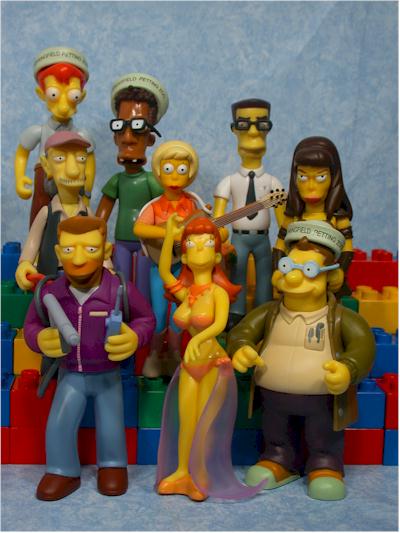
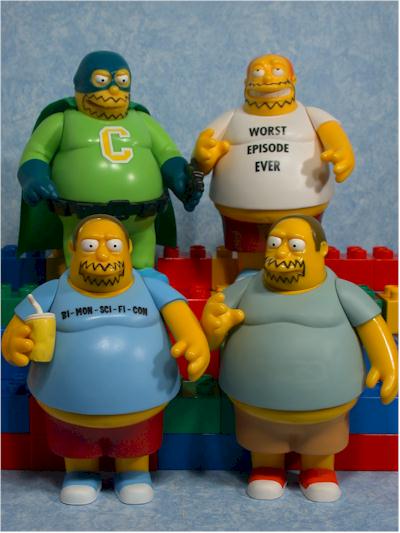
|
|
The other two figures were turned into 'mail aways'. This was something very popular back in the 70's and 80's with kid's lines - collect points off packages to send in and redeem for free figures from the company.
Cooder and Sinclair could be obtained by clipping the POPs from any two figures or playsets from series 1 through 9, or the first two waves of celebrity figures, and you could send them in with the
receipt and five bucks for shipping and handling to get BOTH Cooder and Sinclair. This was a heck of a tremendous offer, but Playmates didn't do it entirely out of the goodness of their heart. Sure, the voice rights and even sculpting costs were already all sunk, so there wasn't too much to lose - but they did have two ulterior motives.
First, they were bouncing around the idea of doing other mail aways starting with series 10. They were pretty sure they'd go forward with it, but wanted to see how well the process
worked. The company they used for the mail aways turned out to be quite good, and even provided an on-line page where you could get updates on your order, a very helpful feature. Best of all, Playmates never ran any shortage of any of the mail aways - if you sent in your coupon during the period of the giveaway (up to 12 months for some of them), you were sure to get your figure.
Second, and more importantly, the line was lagging. Sales of wave 8 and 9 were down, and it looked like the trend wasn't changing. Retailers would be slow to pick up
wave 10 and wave 11 if the pegs were still full, and Playmates was looking at a way to help clean out old stock and keep the big yellow ball rolling.
|
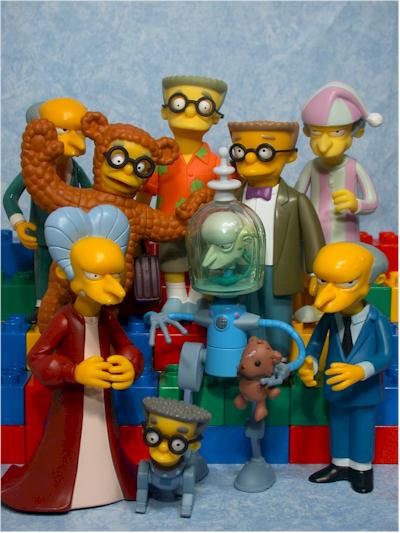
|
|
This was the first of several times that the line was in serious trouble, but the press didn't notice. The awards and accolades for the line kept piling up, but collector's were beginning to get pickier about what figures and what
playsets they picked up. Playsets in particular were starting to hang out a long time on the shelves, particularly less attractive ones (or simply less exciting ones) like the Springfield DMV or the
Retirement Castle. By the end of 2002, with the release of series 10, Main Street, many smaller exclusive environments,
the third THOH, and the New Year's Eve
set, the market had gone soft, and the line was teetering on it's last legs.
BTW, the production numbers on Sinclair and Cooder was the lowest of any released figure through out the series, so if you're a
completist, these are the two to pick up.
Starting with wave 10, a new program began. Buy four figures from the wave, send in the POP's and five bucks to Playmates, and get a
Be Sharp Homer. The theory from the very beginning was to do the complete set of Be Sharps, then do a
play set for the group. After the Be Sharps would come the Stonecutters, and their Stonecutter Hall. Obviously, the idea here was to convince people to buy more of the regular wave figures, and use the mail aways as sort of a loss leader. The program worked fairly well with the Be Sharps,
and Be Sharp Barney, Skinner
and Apu were all produced, as well as
convincing Toys R Us to pick up the Be Sharps
play set as an exclusive. Unfortunately, by the time the Stonecutters started with
wave 14, interest in the line had declined
too far to ever have a chance of seeing the Stonecutter Hall.
|
|
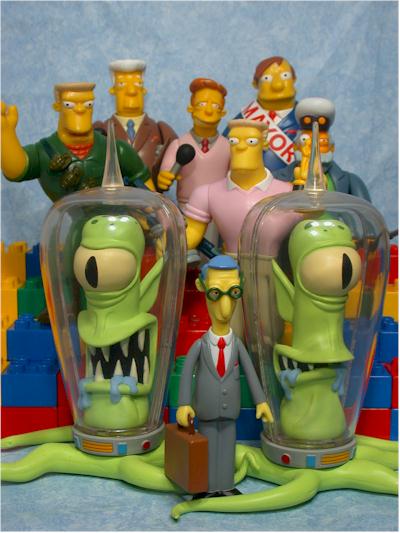
|
|
A second program started in early 2003 - re-releasing older figures. Again, Playmates worked very closely with SCS to determine the most effective way to get this to work. It's a tricky move to pull off - some collectors will be upset by the re-releases if they match the originals exactly, while others will be upset if they don't. The final plan was to release key original characters as two packs, each with their own little sidewalk base that didn't speak, and have them retail for around ten bucks. Each would be in their standard outfit and colors, but
re-sculpted heads would be used to differentiate them from the originals, and also make them interesting to current collectors. The purpose was two-fold - bring in new collectors who might shy away from the line if they couldn't get these early characters, and convince retailers that the line still had legs.
But nothing can ever work smoothly. Target was one of the remaining
large retailers for the line, but by the time Playmates had announced the
new two packs, Target had already set their planogram for the spring
layout. That meant they had no room for any sort of two packs, and
were completely uninterested. To be able to still get them out early,
and not upset Target, Playmates came up with another idea - release the
first two figures mixed in with wave 12. It was Moe and Mr.
Burns, two of the most requested from the early waves. Both were done with the original sculpts, but with slightly different colors. It was actually an attempt by Playmates to get the colors more on target with the way the characters looked in most episodes i.e. Moe had his blue apron instead of white. They also wanted to get Moe back on pegs, since they had just released Moe's Tavern in January. Let's face it, just how good is a Moe's Tavern without a Moe?
|
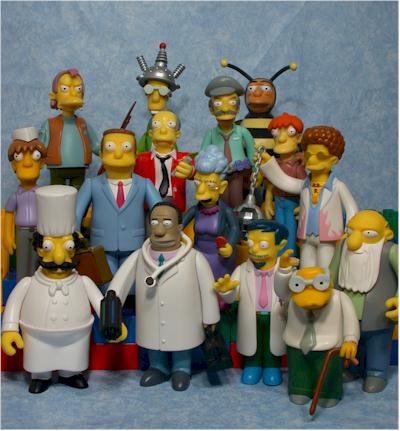
|
|
A another change was made starting in January of 2003 with the wave 11
playsets, or in this case, playset. For the past 10 waves, there were two playsets released each
time (with the exception of that blip back at wave 5). With wave 11 and beyond, only one playset would come out, cutting back on the number of playsets left sitting on the shelves.
Finally, it was decided that there would be very few exclusives released in 2003, at least in comparison to 2002.
The changes were moderately successful in that they did manage to convince the retailers to stick it out through 2003. Collector's should be truly thankful for that, because we saw some of the coolest (and most requested) figures and playsets released that year, including Stephen
Hawking (the only 'celebrity as himself' figure ever released, and one done
because of a special request from Matt Groening and Stephen Hawking), Princess
Kashmir, Gil, Moe's Tavern, Bart's Treehouse, Mr. Plow Homer, the Military Antiques Store, the Collector's Lair, Kilt Willie and the Original Simpsons set.
|
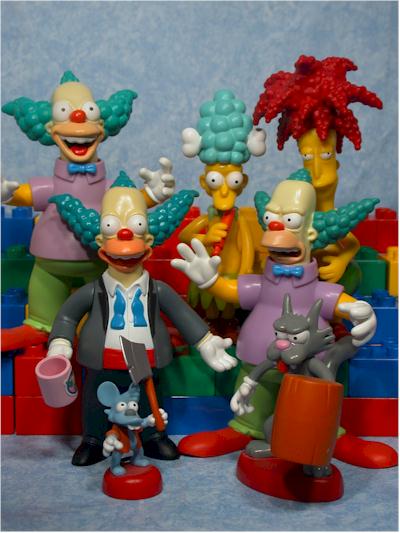
|
|
But I'm getting ahead of myself. That's because all of these programs were being worked on during the late sumer and early fall of 2002. In the spring of 2002, Jeff Trojan had left Playmates, and Pat Linden stepped up to guide the line for the remainder of it's life. Pat developed these ideas with the support of
SCS, and worked extremely hard to keep the line above water.
Late in the summer of 2002, three figures were released that would become the stuff of legendary debates - the
Bongo figures. Bongo is the comic publishing house of
Groening, and had been producing a Simpsons comic book series for
some time. In one of those comics, many of the characters of Springfield were given super powers, and Playmates decided to do figures based on those characters. They would be chipless of course, since they never appeared on the show and therefore never had lines. The first set, carded all together as a Kaybee Toys exclusive, included Homer as the Ingestible Bulk, Apu as Captain
Kwik and Edna Krabapple as Vampiredna. Within days of the first sets hitting pegs, Playmates cancelled the line.
Why? I suspect it got back to the fear that it would get confused with
WOS, and the rule for WOS was if it wasn't on the show, it couldn't get
made.
The big debate for collector's was - are these WOS or aren't they? Technically it's obvious they aren't part of the 'world of
springfield' line. The logo isn't on the packaging, and the figures lack the Intellitronic feature. However, they are made by the same company, are in exactly the same scale, and if you put them on the shelf together, you'd never know the difference. And thus the debate rages on - I can tell you that if I ever do get around to publishing a book on
WOS, I won't leave a discussion and photos of Bongo out.
|
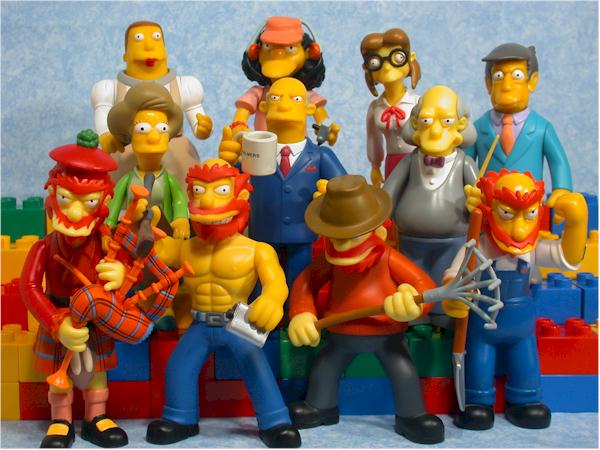
|
|
Playmates tried to do all kinds of other figures and toys during the life of WOS - 9" figures,
blockos, PVC's, RC Bart, etc. etc. etc. None ever met with anything more than moderate success, and most were major failures. Clearly the magic that was WOS wasn't easy to translate.
By the end of 2002, the fly by night collectors and those only buying for investment had fled, leaving only the hard core fans and collectors. Still, it was enough of a market - and the changes implemented by Playmates radical enough - to convince retailers to stick it out. At the beginning of 2003, the SCS once again makes their voice heard over the release of a playset based on the
300th
episode. After seeing the initial sketches, collectors voiced so much disfavor, that Playmates
canceled the set.
2003 was a rocky year. Although some of the most requested characters finally
got made, the line was constantly on the verge of dying. Collectors have no idea how many times it was on the brink, and yet managed to pull back at the last minute. Much of this is due to the efforts of Pat Linden at Playmates and the dedication of TRU to the line, supported by the folks at
SCS. Sales numbers were way down from the heady days of 2002 though, and most people could see the writing on the wall. Maybe, just maybe, Playmates could find a way to get the line to make it through 2004, but it wouldn't be easy.
Lots of ideas came and went. Efforts were put in to create a Collectors Club, and Playmates even announced it at Toy Fair in 2003. Unfortunately, it never did get off the ground, but not for lack of trying. With demand dropping, continuing the mail aways made little sense, and so
Stonecutter Lenny, the mail away with series 15, was the last. By the release of
wave 15 in January of 2004, it was clear the line was finished. The only question was when, and Playmates managed to sell enough retailers on one more wave,
wave 16, that included one of the most requested figures in the final days of the line, Agnes Skinner.
|
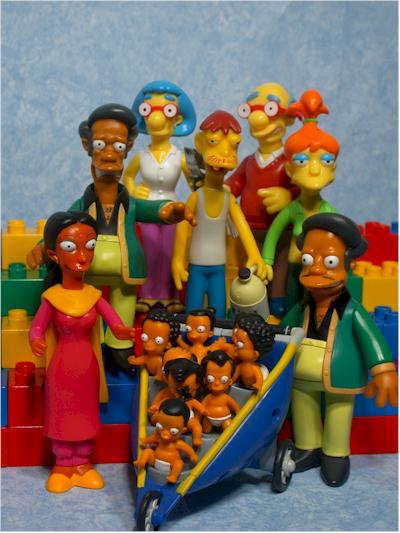
|
|
Let's talk about Agnes for a second - that was an interesting story. Of all the possible female characters, only Maude Flanders out ranked Agnes Skinner on collector interest polls. Playmates began working on getting her in the line way back in 2001. The voice acting was done by the great Tress
MacNeille, who has done hundreds of characters in many, many shows, including shows like Pinky and the Brain,
Futurama, Tiny Toons, and even Dave the Barbarian. Odds are, if you've watched a cartoon in the last decade, you've heard Tress.
Tress voices several important characters on the Simpsons other than just Agnes, including
Brandine,
and Dolph. Someone someplace made a major faux pas however, and Dolph was
released without ever talking with her, or negotiating any contract.
Oops. As you might imagine, her reps and her got pretty upset.
FOX fixed the situation by very quickly cutting a retro-deal for Dolph, but
before a real deal was even finalized, she saw that work had already
progressed on the actual Agnes figure, and she felt it was as if FOX was doing it again.
It didn't help matters that at the time FOX was screwing big time with
Futurama, a show that Tress also worked on and cared very much about. With the already strained relationship with FOX over their handling of that show, and this snafu, she was pretty damn upset, and called off any further talks.
That killed Agnes for wave 10, as her negotiations for the voice rights for
the toys got wrapped up in her overall negotiations with FOX for the show,
and things dragged out. Eventually it was all straightened out, and
finally Playmates was able to go ahead with Brandine and Agnes.
Another interesting story has always been Maude Flanders. The woman that voiced Maude, Maggie Roswell, had a fairly public battle with FOX over her contract on the show.
About a year after she left the show, FOX killed Maude off. For years, the fans begged Playmates for a Maude Flanders figure, but because of the bad blood between FOX and Ms. Roswell, it wasn't happening. Finally, someone somewhere managed to get them back to the table to agree, and Maude Flanders was planned for release with the Rumpus Room set.
Alas, the line was cancelled before she could ever see the light of day. For most collectors, the lack of Maude is the one gaping hole in the overall series.
We didn't miss out on Maggie Roswell characters completely though, as we did
get Princess Kashmir, Helen Lovejoy and Luann.
|
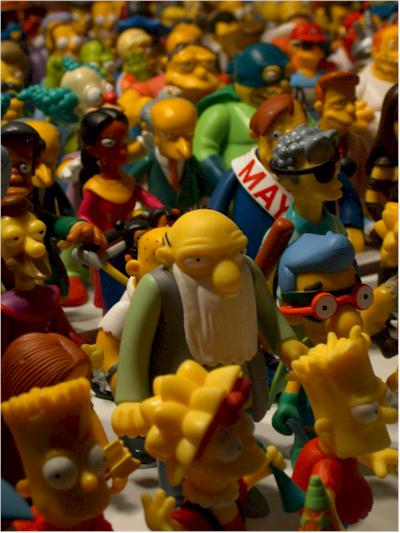
|
|
Speaking of contracts, it's important to note that many of the decisions that Playmates made that collectors thought were odd were often the result of contract issues. For example, why would we get a Brandine figure before we get a Maude Flanders figure? As you can see above, once they worked out the issues with Tress, they had a contract in place that allowed them to do
Brandine, but did not have one for Maude. For them, it made more sense to take advantage of existing contracts rather than spend the fees and extra cash to get a new contract. Another example would be if they had a contract with someone that voice four characters that was about to run out, but they had already produced only three. From a business perspective, it made sense to try to get that fourth figure produced, if it was one they really wanted in the line at some point, rather than wait and have to renegotiate a new contract later.
The final playset has now hit stores, or at least on-line stores - the Town Square with Jebediah Springfield. There was talk during this past winter of producing one final playset for the THOH line with Toys R Us, but it hit a big snag when FOX, Playmates and TRU couldn't agree over the theme. Two themes were developed, one containing characters from the Island of Dr. Hibbert based on his
'house of
pain', the other containing characters from a variety of shows that fans had been clamoring for, like the Frogurt Guy, in the
Haunted
Mansion. Both made it all the way to sketches, which were shown to the
folks at SCS.
FOX wanted the manimals, but Playmates wasn't comfortable with that, and felt the Haunted Mansion would be a much better seller. Once again they came to the
SCS, and based polled their opinions. It was an overwhelming majority that wanted the Haunted Mansion over the House of Pain, but FOX refused to budge. In the end, Playmates and TRU backed out, believing that the set would not sell.
|

|
|
So now the fat lady sings, and it's time to say good bye to the World of Springfield, at least as an action figure series.
Almost five years have gone by, with over three dozen playsets and 200
action figures. Will another company try again one day to do Simpsons action figures? Perhaps, if the movie finally ever gets made, but it's unlikely that anyone will ever top this line. Playmates can be proud that they produced the definitive set of action figures for this show, something that only happens once in a career if you're lucky.
It amazes me that even after this long of
article, there's tons I could talk about. There's the variants and
errors, delays, cancelled sets and figures, almost cancelled sets (can you
say Burn's Manor?), great custom figures and playsets, the stories behind
why some figures never made it (like Dederick Tatum and Lucious Sweet), and
so very much more. After almost five years, it's no surprise that
there's so much history. I've been privileged and proud to be involved so closely with this line over the years. People like Jeff Trojan and Pat Linden at Playmates proved how valuable listening to the customers - collectors - can truly be, and it was always a pleasure to talk and work with them. The folks at SCS,
especially Mark Lindsey, Jonathan Cook and Jeremy Wilcox, helped develop and maintain one of the best collector based web sites and message boards I've ever had the pleasure of using.
And while we have spent many a message board post claiming that they all
have horns and pointy tails, the folks I've met and talked to at FOX have
been far nicer than you'd ever imagine. Collectors may not have agreed
with every decision, but FOX was willing to work with Playmates to create
one of the greatest lines of all time.
|
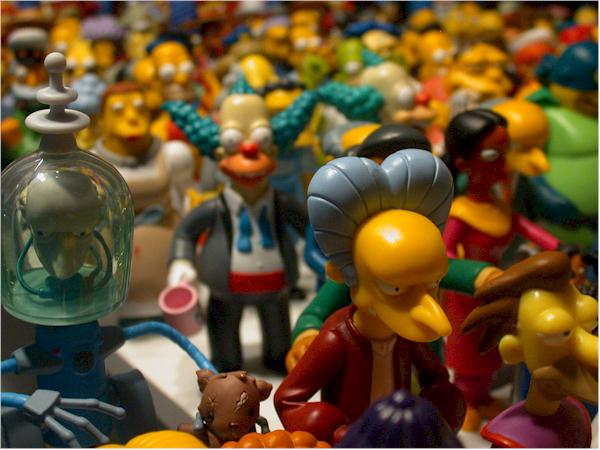
|
|
Of course, the biggest thanks goes out to all the collectors that I've met with and talked to about WOS. They've managed to make my collecting experience that much more fulfilled and fun, and they are some of the nicest collectors I've known.
For me, collecting marches on. I just spent far too much money on Ren and Stimpy and Incredibles action figures this month, and there's always something new right around the corner. But my collection of WOS will be with me forever, and will always be a big part of my
permanent display. I'll miss buying these little pieces of yellow plastic, but hopefully the friendships that have developed will continue long after the end of the line.
I've put together a page listing all the
reviews I've done on World of Springfield toys in a single
place, and I thought I'd end this article with a few final photos of one
of my favorite lines of all time. Happy collecting, everyone!
|
This is what it looked like at the San Diego Comic Con last summer...
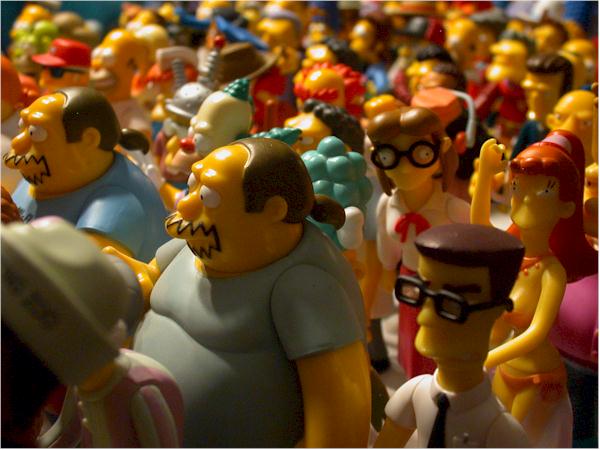
|
|
|
 |
 |
|
|

